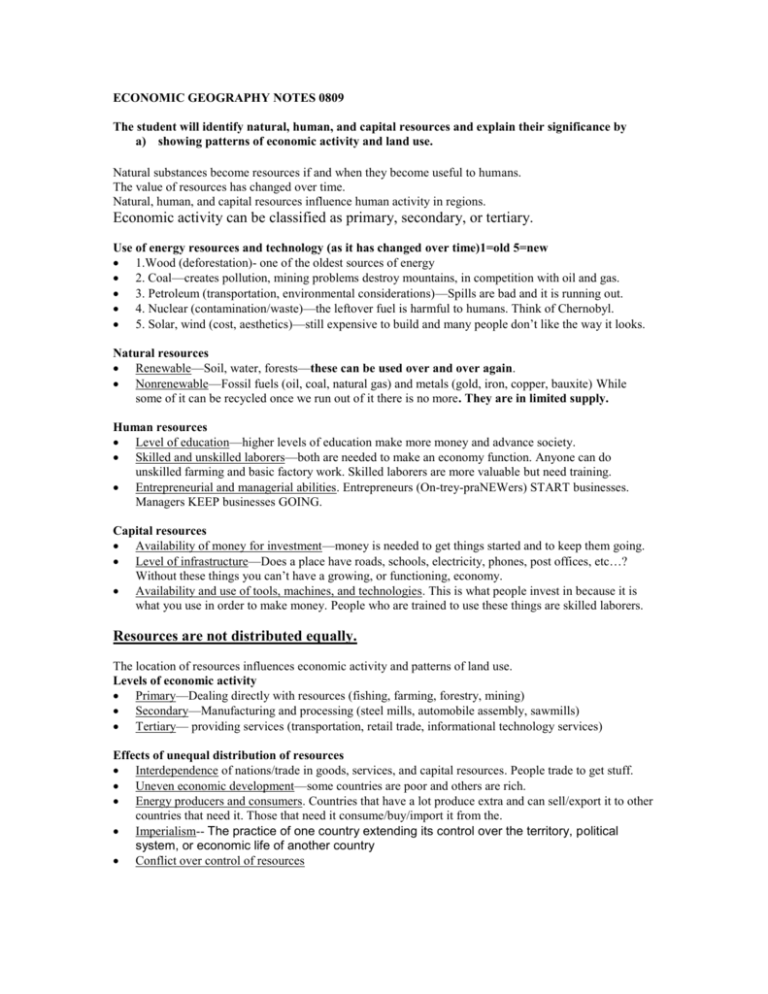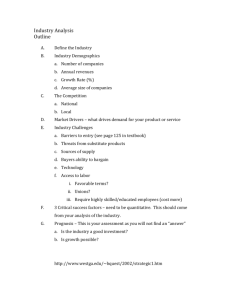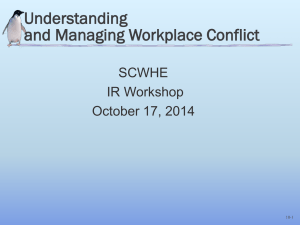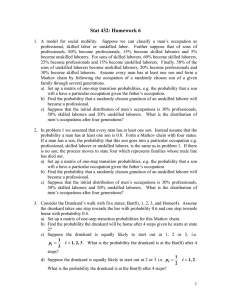The student will identify natural, human, and capital
advertisement

ECONOMIC GEOGRAPHY NOTES 0809 The student will identify natural, human, and capital resources and explain their significance by a) showing patterns of economic activity and land use. Natural substances become resources if and when they become useful to humans. The value of resources has changed over time. Natural, human, and capital resources influence human activity in regions. Economic activity can be classified as primary, secondary, or tertiary. Use of energy resources and technology (as it has changed over time)1=old 5=new 1.Wood (deforestation)- one of the oldest sources of energy 2. Coal—creates pollution, mining problems destroy mountains, in competition with oil and gas. 3. Petroleum (transportation, environmental considerations)—Spills are bad and it is running out. 4. Nuclear (contamination/waste)—the leftover fuel is harmful to humans. Think of Chernobyl. 5. Solar, wind (cost, aesthetics)—still expensive to build and many people don’t like the way it looks. Natural resources Renewable—Soil, water, forests—these can be used over and over again. Nonrenewable—Fossil fuels (oil, coal, natural gas) and metals (gold, iron, copper, bauxite) While some of it can be recycled once we run out of it there is no more. They are in limited supply. Human resources Level of education—higher levels of education make more money and advance society. Skilled and unskilled laborers—both are needed to make an economy function. Anyone can do unskilled farming and basic factory work. Skilled laborers are more valuable but need training. Entrepreneurial and managerial abilities. Entrepreneurs (On-trey-praNEWers) START businesses. Managers KEEP businesses GOING. Capital resources Availability of money for investment—money is needed to get things started and to keep them going. Level of infrastructure—Does a place have roads, schools, electricity, phones, post offices, etc…? Without these things you can’t have a growing, or functioning, economy. Availability and use of tools, machines, and technologies. This is what people invest in because it is what you use in order to make money. People who are trained to use these things are skilled laborers. Resources are not distributed equally. The location of resources influences economic activity and patterns of land use. Levels of economic activity Primary—Dealing directly with resources (fishing, farming, forestry, mining) Secondary—Manufacturing and processing (steel mills, automobile assembly, sawmills) Tertiary— providing services (transportation, retail trade, informational technology services) Effects of unequal distribution of resources Interdependence of nations/trade in goods, services, and capital resources. People trade to get stuff. Uneven economic development—some countries are poor and others are rich. Energy producers and consumers. Countries that have a lot produce extra and can sell/export it to other countries that need it. Those that need it consume/buy/import it from the. Imperialism-- The practice of one country extending its control over the territory, political system, or economic life of another country Conflict over control of resources Patterns of land use Proximity of natural resources to economic activity: You can find some economic activities near the resources that they need to make it happen. Memorize these Examples: steel is near coal; cattle ranching is near grain; fishing is in the ocean; aluminum smelting is near hydro-electric power. Non-proximity of resources to economic activity: Sometimes a place is not-near the resources it needs. Japan has Limited natural resources but they are a major manufacturing country because they import what they need; United Arab Emirates (UAE) has abundant Oil but lacks of industry. The student will identify natural, human, and capital resources and explain their significance by b) evaluating perspectives and consequences regarding the use of resources. The use of a resource depends on a nation’s culture, values, access to technology, and governmental priorities as they change over time. How and why do different cultures develop different perspectives on the use of resources? What are some costs and benefits in the use of resources? Social and economic priorities that influence a culture’s perspective on resources Economic development priorities—countries have to decide what is most needed. Schools or bridges? Environmental conservation priorities- How do we decide whether to preserve forests or sell the wood? Priorities of indigenous minorities- If a tribe lives on a mountain, can we still do mining there? Examples of technologies that have created demand (need) for particular resources Steam engines created a demand for coal. Coal was less valuable before the steam engine. Internal combustion engine (used in cars and trucks) created a demand for gasoline (petroleum) Computer chips created a demand for skilled labor because someone has to know how to use them. Costs Resource depletion—Especially for non-renewables—once they are gone they are gone. Environmental degradation—this can lead to health problems and damage to the ecosystem. Health problems—lung disease from polluted air—cancer from radiation—death from overexposure. Benefits Production of goods and services—You have to use resources to make stuff and get money. Employment opportunities—resources make jobs possible. Jobs provide money. Money buys stuff. Development of technologies—you have to have resources to make new technology. The student will distinguish between developed and developing countries and relate the level of economic development to the standard of living and quality of life. Levels of economic development vary from country to country and from place to place within countries. Many criteria are used to assess the standard of living and quality of life. Resources and technology influence economic development and quality of life. Differences between developed and developing nations. Developed Developing Access to natural resources Abundant Scarce Access to capital resources Abundant Scarece Numbers and skills of human Many high skilled workers Few skilled workers, many resources unskilled workers Levels of economic development Many 3rd and 4th level jobs Mostly primary and secondary Standards of living and quality of High Standard of Living Low Standard of Living life Relationships between economic High Quality of life Low Quality of Life development and quality of life Indicators of economic development Urban/rural ratio= how many people life in the city vs. in the countryside Labor force characteristics (primary, secondary, tertiary sectors)= developed have more 2nd and 3rd GDP per capita= total amount of goods and services divided by the population (wealth per person) Educational achievement= developed countries tend to have higher literacy and education levels. Indicators of standards of living and quality of life Population growth rate (natural increase)= birth rate – death rate Population age distribution= how many males and females in each age group. Literacy rate= number of people (per 1000) who can read. Life expectancy= Average age that people are expected to live Infant mortality= number of babies (per 1000) who die before 1 st birthday. Percentage of urban population= number of people who live in the city. The student will analyze the global patterns and networks of economic interdependence by a) identifying criteria that influence economic activities. Resources are not equally distributed. Economic activities are influenced by availabiltiy of resources, cultural values, economic philosophies, and levels of supply and demand for goods and services. No country has all the resources it needs to survive and grow. Criteria that influence economic activity Access to human, natural, and capital resources – Skills of the work force – Natural resources – Access to new technologies – Transportaion and communication networks – Availability of investment capital Location and ability to exchange goods – Landlocked countries= countries completely surrounded by land w/o access to a waterway. – Coastal and island countries – Proximity to shipping lanes – Access to communication networks Membership in political and economic alliances that provide access to markets—e.g., European Union (EU), North American Free Trade Agreement (NAFTA) The student will analyze the global patterns and networks of economic interdependence by b) explaining comparative advantage and its relationship to international trade. Resources are not distributed equally. No country has all the resources it needs to survive and grow. Terms to know Comparative advantage: Countries will export goods and services that they can produce at lower relative costs than other countries. Effects of unequal distribution of resources Specialization in goods and services that a country can market for profit Exchange of goods and services (exporting what a country can market for profit; importing what a country cannot produce profitably) Some countries’ use of resources Japan—Highly industrial nation despite limited natural resources Russia—Numerous resources but they are hard to get to because of cold rough terrain. United States—Diversified economy, abundant natural resources, specialized industries Côte d’Ivoire—Limited natural resources, cash crops in exchange for manufactured goods Switzerland—Limited natural resources, production of services on a global scale Reasons why countries engage in trade To import goods and services that they need To export goods and services that they can market for profit Effects of comparative advantage on international trade Enables nations to produce goods and services that they can market for profit Influences development of industries (e.g., steel, aircraft, automobile, clothing) Supports specialization and efficient use of human resources The student will analyze the global patterns and networks of economic interdependence by c) describing ways that economic and social interactions have changed over time. Economic, social, and therefore spatial relationships change over time. Improvements in transportation and communication have promoted globalization. Changes that have occurred over time Industrial labor systems (e.g., cottage industry, factory, office, telecommunications) Migration from rural to urban areas (aka Urbanization) Industrialized countries export labor-intensive work to developing nations Growth of trade alliances Growth of service (tertiary) industries Growth of financial services networks and international banks Internationalization of product assembly (e.g., vehicles, electronic equipment) Technology that allows instant communication among people in different countries Modern transportation networks that allow rapid and efficient exchange of goods and materials (e.g., Federal Express, United Parcel Service, U. S. Postal Service) Widespread marketing of products (e.g., Fuji film, Nike, United Colors of Benetton) The student will analyze the global patterns and networks of economic interdependence by d) describing and evaluating the formation of economic unions. As a global society, the world is increasingly interdependent. Everyone needs each other to get the things that they want. For example, your shoes and clothes come from China, electronics from Japan, food from the USA, art, music, and fashion from European countries, etc… Examples of economic unions EU—European Union NAFTA—North American Free Trade Agreement ASEAN—Association of Southeast Asian Nations OPEC—Organization of Petroleum Exporting Countries Advantages of economic unions – countries can do more when they work together. More efficient industries Access to larger markets Access to natural, human, and capital resources without restrictions Greater influence on world market Disadvantages of economic unions—they benefit big businesses and sometimes lead to arguments Closing of some industries Concentration of some industries in certain countries, leaving peripheral areas behind Agribusiness replacing family farms Difficulty in agreeing on common economic policies Economic interdependence fosters the formation of economic unions. Unions happen because all of the countries already need each other so they just agree to officially work together and set rules.








